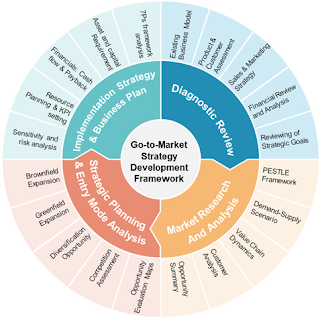What Is The Go To Market Strategy? How To Plan Effective Utilization Of Your Resources With Go To Market Strategy.
A go-to-market strategy can be defined as an action plan that companies can design to succeed in the market. It is an essential activity for a company in order to launch new offerings, rebuild the brand, or explore new markets.
The main objective of a go-to-market strategy is to ensure positive business outcomes. To design an effective go-to-market strategy, businesses need to research and understand the following factors:
Current market trends
Target audience and behavioral patterns
Distribution channels frequented by target audience
USP of a company’s brand
Pricing strategy of the product
A go-to-market strategy helps in the optimal utilization of available resources. The steps for building a go-to-market strategy are:
Buyer persona – To create a buyer persona, the brand must identify its target markets and customer base. It should then determine how to reach target customers, their preferences, buying patterns, etc., to obtain a complete picture of who would be their potential customers.
Value matrix – A value matrix maps an offering against the needs of customers. It defines the purpose and reason for the product/service to be offered to specific customers. It also identifies specific needs of customers that could be fulfilled by the feature/process of the product/service.
Marketing strategy – To position a product in the market, the brand must test different advertising formats and platforms. The strategy must be able to increase brand awareness, generate leads, and help retain existing customers.
Competitive analysis – Competitive analysis is essential to understand the strategy of major players in the market. It helps the brand in understanding market trends and in being aware of any new disruptive technology that the competition might be launching.
Pricing strategy – The pricing structure should be based on the business model and be of value for money to customers. The pricing structure followed by competition must be analyzed before finalizing the cost.
Sales strategy – This part of the process is related to the actual launch in the market. The organization must train its sales staff, arm them with relevant material, and identify best routes to approach target customers.
Distribution channels/models – The best suitable channel/manner of distribution must be designed to ensure that the offering is readily available and accessible to the target customers.
Determining success matrix – Companies should essentially track the success of a launched offering. This metric must be defined in a go-to-market strategy, and it should be measurable and easy to monitor.
Ongoing budget – A company must determine the ongoing financial investment that would be needed once the product has been launched. This investment must be in place to ensure that the product marketing and positioning continues as per the defined go-to-market strategy.
A robust go-to-market strategy framework is essential for every company that aims to branch out. It aids in outlining a clear business plan.


Comments
Post a Comment